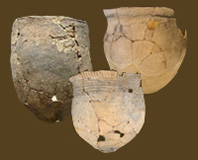
|
|
Vinette Defining Attributes Vinette is an Early to Middle Woodland ware, characterized by crushed rock temper, cord-marked exterior and interior surfaces, and a conoidal shape. It is named for the Vinette site in New York, and is tied to various cultures of the Northeast. The ware includes two types: Vinette I, and Vinette 2 dentate stamped variants. The latter have not been found in Maryland; however, some of the interior/exterior cord-marked ceramics recovered from Early to Middle Woodland contexts in Maryland appear to be Vinette variants (Wall 1992). Chronology Stratigraphic sequences and radiometric dating indicate that Vinette dates from ca. 1200 B.C. to 100 B.C., although some earlier and later dates have been reported. The date range seems to vary geographically; for example, in eastern Pennsylvania and the lower Delaware Valley, Vinette I seems to disappear after 600 B.C. (Custer 1996; Stewart 1998). In central New York, production of Vinette I peaks between 1000 B.C. and 500 B.C. (Sassaman 1999). In Maryland, a date range of 1000 B.C. to 100 B.C. has been suggested (Stewart 1982). Distribution Vinette ceramics are found along the east coast from New England to Maryland and west to central New York and the Ottawa valley of eastern Ontario. In Maryland, it has been found primarily in rockshelters and in surface collections on sites in the western part of the state (Gross 1972; Stewart 1981). Vinette I is rare east of the Hagerstown Valley, although it was reported at the Conowingo Site (18CE14) along the Susquehanna River in far northeastern Maryland (Custer et al. 1983). Description Paste/Temper Surface Treatment Decoration Morphology Defined in the Literature Type Site Maryland sites with
Vinette components Radiocarbon Dates References Custer 1996; Custer et al. 1983; Gross 1972; Kraft 2001; Ritchie and MacNeish 1949; Ritchie 1944, 1965; Sassaman 1999; Stewart 1981, 1982, 1998; Spence et al. 1990; Wall 1992. |
|

|
Thank you for visiting our website. If you have any
questions, comments, Copyright © 2002 by |

|



